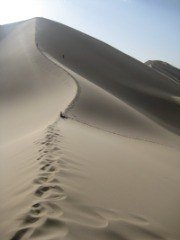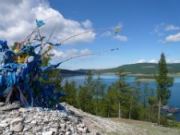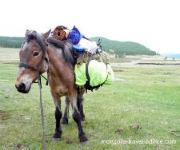|
The Gobi Desert: geography, wildlife, history, tours, pictures, attractions, camel riding, and how to get there.
Page Contents:
The Gobi desert contains tall sand-dunes, rocky hills, gorges and canyons. These places form the 'sights' of the desert, but the majority of it -and the part you'll remember most- is flat, rocky nothingness. Those from Australia and the United States might be familiar with such vastness, but even for them the Gobi can be an unforgettable experience. Driving across the smooth dirt tracks, you soon get a feel for the desert, and begin to notice the subtle changes in the geology and vegetation that occurr every few kilometres. Hardy Mongols have managed to eek out a precarious living herding on the dry plains. Yurts punctuate the plains now and again, and you'll undoubtedly get the opportunity to visit one, share some tea, and see how these amazing people survive out here. Getting There Distances are great, water is scarce, and a vehicle breakdown can be fatal. The vast majority of people will organize a tour; those going to the (significant) trouble of organizing their own transport should have two vehicles in the party, lots of water, a GPS, and preferably a Sat phone. The Gobi Desert is scattered by small settlements, and the towns of Madalgov and Dalanzadgad offer the basic necessities but little to do or see, and tourist infrastructure is limited. You can easily reach these towns by public transport, but once you're there you may not be able to get out to anywhere interesting. My advice is to spend your research effort on finding a good tour from Ulan Bator. Those desperate to do things independently should consider finding a good guide in UB. You should then be able to find a car and driver for hire in one of the Gobi desert towns, but ensure they have the requisite mechanical skills and are carrying a lot of food and water: out in the Gobi, you're entrusting your life to these people.
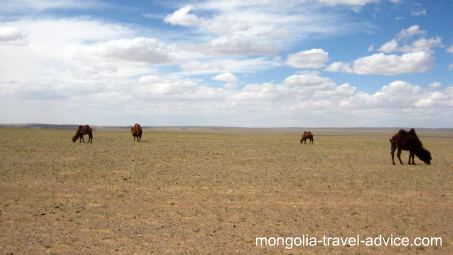
The Gobi desert is Asia's largest desert. A high, dry plain stretching half a million square miles, it covers a third of Mongolia and a good part of China. The 4000m Tibetan plateau forms the Gobi desert's southwest edge, it is this and the Himalayas which block weather and starve the desert of rainfall from the South. The desert stretches southeast into Chinese Inner Mongolia, its sands growing closer to Beijing with each passing year. The Altai mountains contain the desert in the northwest, and to the north the desert plains gradually give way to the rolling green hills of Central Mongolia. The Gobi desert averages about 1,500 metres in elevation, which is why the annual mean temperature is below freezing. Temperatures vary greatly; it can get up to 40 degrees (over 100F) in August, and down to negative 40 (-40F) in winter. Even in summer, night-time temperatures can fall below freezing, so make sure you pack warm. Freezing sandstorms can blow in quickly, and reduce visibility to a couple of meters. Back to Top 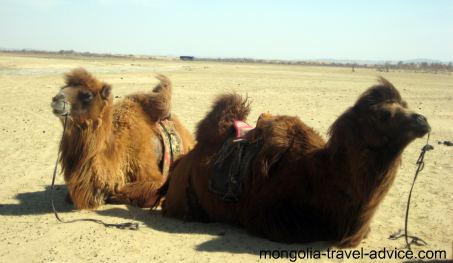
A surprising range of animals survive in the Gobi desert. Bactrian camels are commonly herded by local nomads, you'll probably see some wild ones, too. You may hear wolves, but will be lucky to see any. Antelope, Takhi horses, and the Mongolian Wild Ass populate the semi-desert areas towards Central Mongolia; you should see some in the distance if you keep a look out. Crazed foreign hunters will pay big money to climb the rocky Gobi desert hills after magnificent Ibex and wild Argali Sheep; keep watching the mountainsides when you're hiking and you might see some, too. You would be extremely lucky to see the small Gobi Bear, a sub-species of the Asian brown bear. There are only a handful left in the wild. Importantly, beware the legendary Mongolian Death Worm, a thick, red, intestine-like creature so poisonous you will die upon contact. This fearsome creature has been part of Gobi desert folklore for centuries. Its existence isn't exactly verified by modern science, but that hasn't stopped a lot of people writing web pages about it, and many locals still say they know somebody-who-knows-somebody who's seen one. Perhaps you could devote your life to discovering it and converting it to Christianity. Back to Top 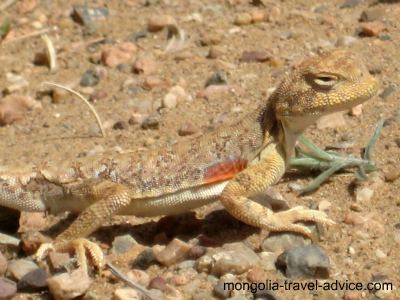
The Manchus, under the Qing dynasty, occupied Mongolia after the fall of the great Mongol Empire, but the challenges the Gobi desert presented to travel, settlement, and military movements helped maintain Mongolia's independence from China into the modern era. Copyright mongolia-travel-advice.com. Without the Gobi desert as a barrier, Mongolia could well have suffered the fate of Chinese Inner Mongolia. For 2,700 years, the Silk Road (or, really, a number of different trade routes) wound its way mostly through the southern, or Chinese, reaches of the Gobi and the adjoining Taklimakan desert. But in the 13th century, at the rise of Genghis Khan, caravans carrying jewels, metals, weapons, slaves, silk, spices, perfumes, and a variety of sexual diseases made their way across the Gobi to open steppe. These goods were carried by merchants in pursuit of trade, or sent by subjugated kingdoms in Northern China as dues of allegiance and protection. During the prolonged Mongol wars, conquering war parties would send back hordes of loot, and thousands of captured engineers, artisans, scribes, pharmacists, administrators, blacksmiths, astrologers...anybody who could be of use to the Empire. Chinese scholars recorded 'rivers of silk' leaving their lands and flowing up through the Gobi to Mongolia. Karakorum, above the northern fringes of the Gobi, attracted merchants, missionaries, envoys, and adventurers from allover Eurasia, all who made their way across the Gobi. The famous Marco Polo crossed the Gobi to Karakorum, on assignment from Kublai Khan's Peking. Karakorum was once a cosmopolitan city, full of countless languages and currencies, and warehoused one of history's greatest accumulations of wealth and loot. When you're in the Gobi desert, try to imagine how these caravans of loot and captives shimmered their way across the plains 800 years before you. When you're wondering the dusty streets and dilapidated Soviet structures of Karakorum, try (as hard as it is!) to envisage what was once the center of the biggest empire the world has ever known. More recently, the Gobi was brought back into the popular imagination by American adventurer-paleontologist, Roy Chapman Andrews. Commonly considered the inspiration for the fictional Indiana Jones character, Andrews mounted a number of intrepid expeditions into the Gobi during the 1920s. At that time the Gobi was largely unmapped and unsettled, and completely lawless as a result of the upheaval between the end of Manchu rule and the commencement of Soviet purges. Andrews combated bandits, vipers, spies and deadly sandstorms. Not inclined to understate, the dashing adventurer related embellished tales of derring-do back the the world's newspapers, who reported his adventures and made him an international celebrity. Fawning young women beset him wherever he went, a phenomenon rarely experienced by modern-day paleontologists.Andrews discovered a huge amount of dinosaur bones and dinosaur eggs at the rocky foothills of the Gobi. His Mongolian fossil discoveries rank as some of the most significant in the world. Of particular scientific importance was the discovery of fossilized evidence of a period of co-existence between mammals and dinosaurs. On Andrew's first visit, he gained audience with the Mongolian President. It joys me to inform you that the president requested he capture the alegorhi-horhai, or Mongolian Death Worm, advising him to use long steel forceps and wear 'dark glasses so that the disastrous effects of even looking at so poisonous a creature would be neutralized'. Surprisingly, Andrews never found one. Back to Top 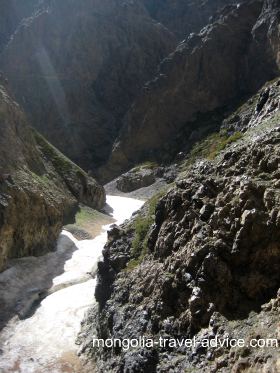
In addition to this, there are some common stops for tourists, most in the spectacular Gurvansaikhan National Park at the south of the Gobi. The Ice Gorge of Yolyn Am sits between steep, beautiful rocky hillsides. Its sheer depth and the area's elevation helps keep (you guessed it) ice at the bottom of the gorge right up until May. Visitors park near a small but endearing museum and walk the 2km to the gorge. There may be an enterprising local with a camel at hand to take you there. Keep a look out for Argali sheep up on the steep rocky walls.The Gobi Sand Dunes are a must-see. Constant desert winds blow sand across the desert until it is trapped against the Gurvansaikhan Mountains. Over the millenia, these dunes have grown up to 300 metres (almost 1,000 feet). The Khongor sand dune is the tallest and most-climbed, but the dunes strech over 100km (55 miles) along the mountains, so if that looks busy there are plenty of others. The climb up can be hot and taxing. Take your time, bring water, and the view from the top has to be one of the most stunning in Mongolia. Most people imagine the Gobi desert as a sandy wasteland, whereas sand covers less than 5% of the desert: this is your opportunity to take a photo of you on a camel, backed by tall dunes, and reinforce a pleasing stereotype to all your friends back home. The Flaming Red Cliffs were named by Roy Chapman Andrews due to the blood red sunsets which paint these rocky hillsides. Andrews made many of his fossil finds here. They're a common stop on tours; amateur paleontologists can wonder and attempt to find dinosaur egg fragments, others can just have a vodka and enjoy the sunset. There are good roads, ger camps and facilities around Gurvansaikhan, so allow yourself some time to explore it properly. Most visitors will be on a tour, who will arrange accomodation for you, and camel rides abound if you have the urge. Back to Top 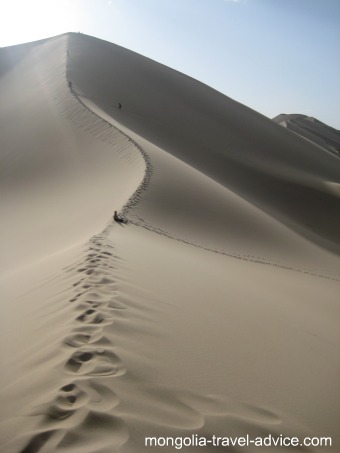
Camel rides typically last for only a few hours, most people are thankful for this as camels don't have as comfortable a motion as a horse, and tend to smell. Their drooly saliva is also to be avoided, and its smell will never wash out of your clothes. Despite such drawbacks, there is nothing stopping you taking a longer ride if you have the time. Ensure you take an experienced local guide, as losing camels or not finding water could mean a quick death out here. An overnight ride, and an evening camp on the dunes, is a great experience, but be prepared for a cold night, and take proper sun protection for the day time. You can wrap a shirt or a long cloth around your head and face like they do in the Sahara. Yes, you will look stupid, but there won't be people around to laugh at you, and it will save your skin from the dry desert winds: it's amazing how quickly you can get wind burn out there. Some more masochistic adventurers might like a week-long camel ride, it wouldn't be as pleasant as a horse ride in other parts of Mongolia, but it sure would be memorable. Copyright mongolia-travel-advice.com. Stock up on all the food you need, and bring water containers. Locals we be willing to take you for as long as you like. Personally, a 2-day camel ride is an enjoyable maximum. I did one and it left me with a great respect for those who manage to call the Gobi desert home. Back to Top 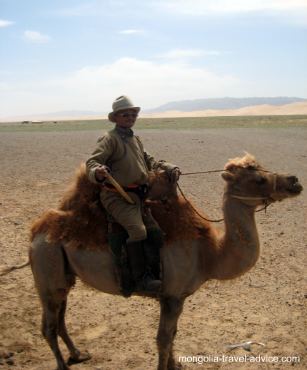
You need to organize your tour from Ulan Bator! Don't think you can just take a bus to Dalanzagdad (the biggest city in the Gobi desert) and expect to find tour operators -or anybody who can speak much English, for that matter. A common Gobi desert tour itinerary is a 'big loop' which heads straight South from Ulan Bator, taking in the flaming cliffs and sand dunes, before looping back northwards towards Karakorum. From there it's either back to Ulan Bator, or continue the trip through Central Mongolia to Lake Khovsgol. Hovd Tour do a fully-catered, 12-day tour of the Gobi desert. To learn more about them, click here. To send them an inquiry, fill out the form below and they'll respond with a quote and a detailed itinerary.
Return from my Gobi desert page to my Mongolia Travel page
|
